Critical Analysis: Violence Faced by Community Nurses
VerifiedAdded on 2023/04/07
|7
|1298
|428
Report
AI Summary
This report provides a critical analysis of workplace violence in community healthcare nursing. It begins by defining community health nursing and outlining the roles and responsibilities of community health nurses. The report then focuses on the issue of workplace violence, detailing the various forms it can take, including criminal intent, client-related violence, and worker-on-worker incidents. It explores the causes of such violence, such as differentiation, interdependence, and poor communication, and discusses the serious consequences for nurses, including psychological distress, reduced productivity, and physical harm. The report also examines interventions and coping strategies, such as individual counseling and peer support, and emphasizes the importance of prevention strategies, including breaking down communication barriers, assessing safety, and creating violence prevention policies. The analysis uses current research and the latest standards of practice to offer a comprehensive understanding of this critical issue.
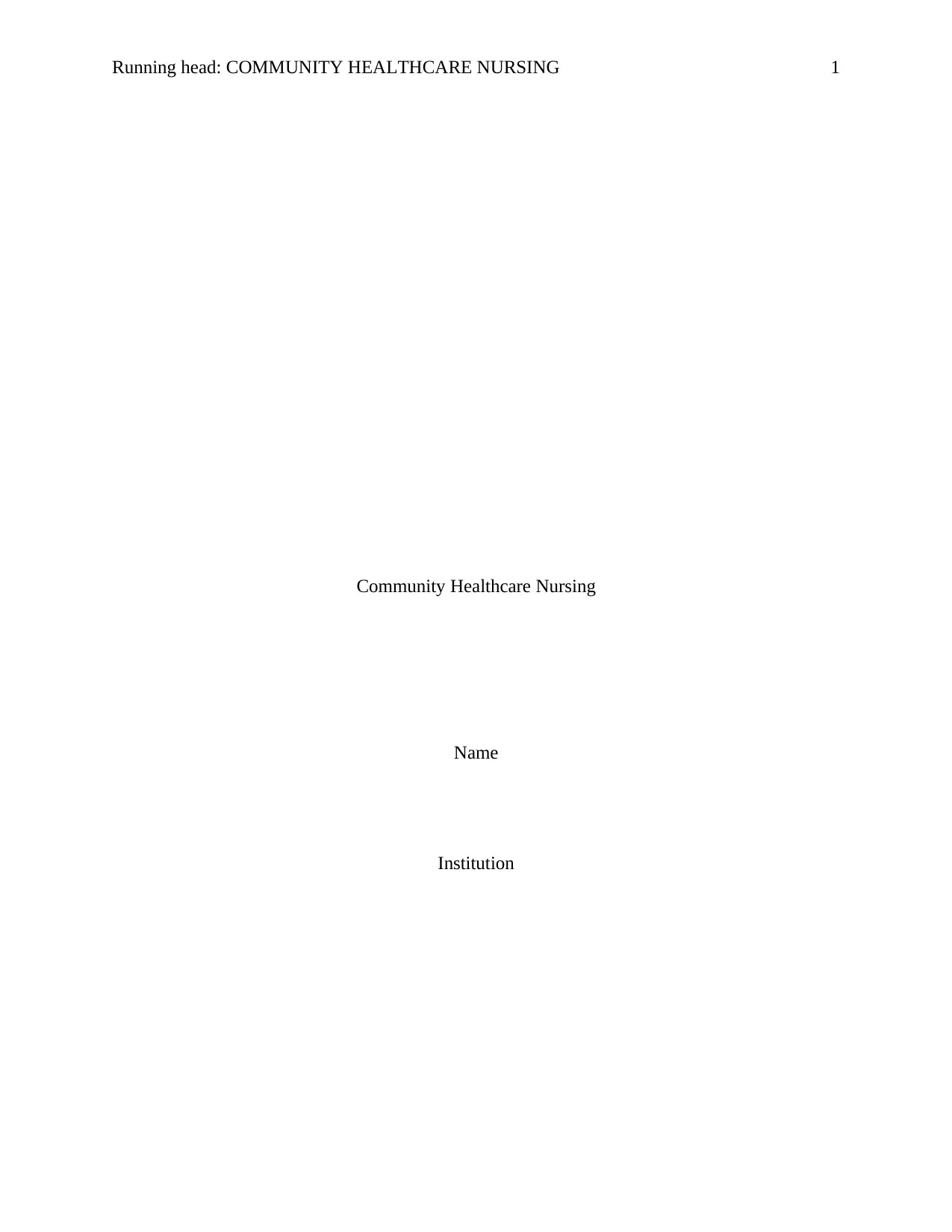
Running head: COMMUNITY HEALTHCARE NURSING 1
Community Healthcare Nursing
Name
Institution
Community Healthcare Nursing
Name
Institution
Paraphrase This Document
Need a fresh take? Get an instant paraphrase of this document with our AI Paraphraser
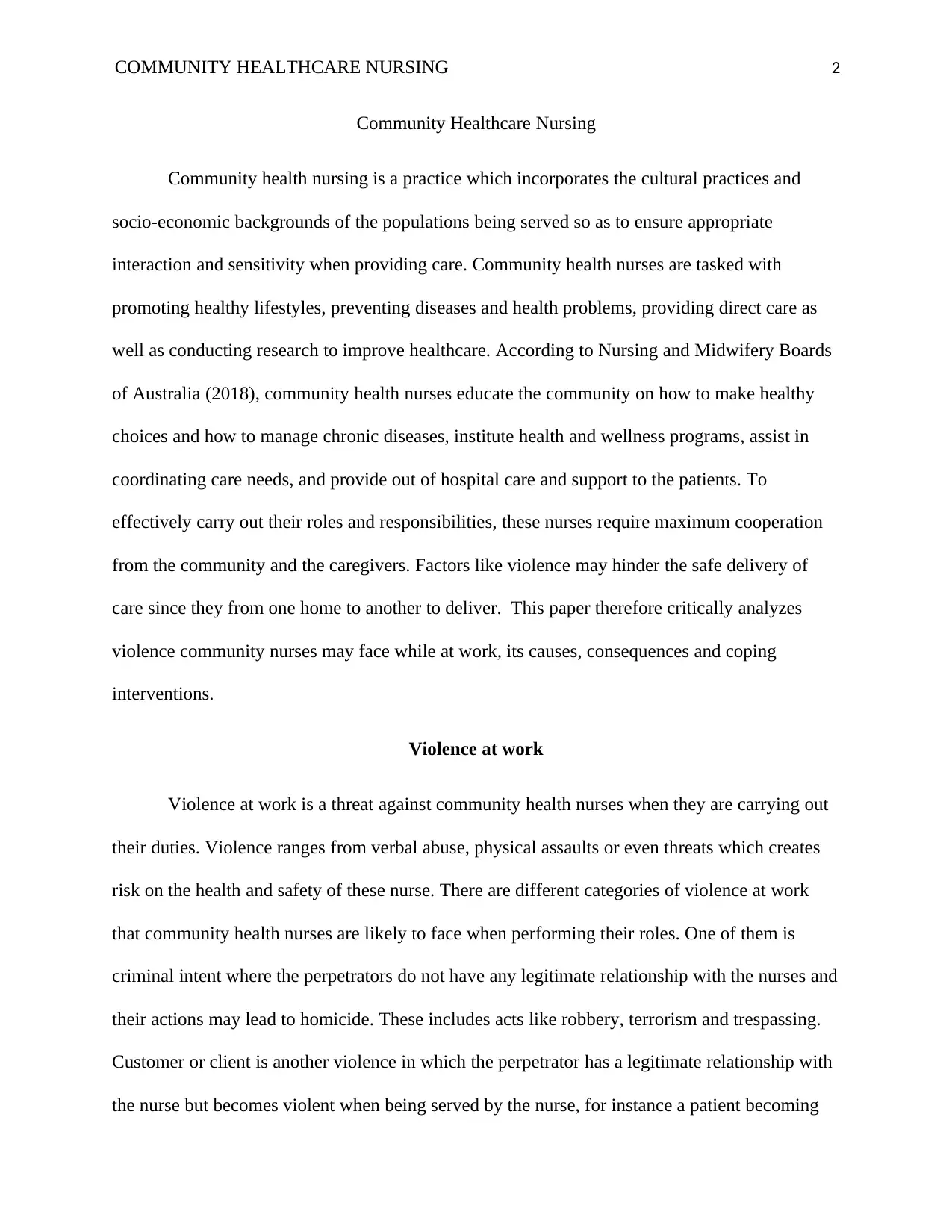
COMMUNITY HEALTHCARE NURSING 2
Community Healthcare Nursing
Community health nursing is a practice which incorporates the cultural practices and
socio-economic backgrounds of the populations being served so as to ensure appropriate
interaction and sensitivity when providing care. Community health nurses are tasked with
promoting healthy lifestyles, preventing diseases and health problems, providing direct care as
well as conducting research to improve healthcare. According to Nursing and Midwifery Boards
of Australia (2018), community health nurses educate the community on how to make healthy
choices and how to manage chronic diseases, institute health and wellness programs, assist in
coordinating care needs, and provide out of hospital care and support to the patients. To
effectively carry out their roles and responsibilities, these nurses require maximum cooperation
from the community and the caregivers. Factors like violence may hinder the safe delivery of
care since they from one home to another to deliver. This paper therefore critically analyzes
violence community nurses may face while at work, its causes, consequences and coping
interventions.
Violence at work
Violence at work is a threat against community health nurses when they are carrying out
their duties. Violence ranges from verbal abuse, physical assaults or even threats which creates
risk on the health and safety of these nurse. There are different categories of violence at work
that community health nurses are likely to face when performing their roles. One of them is
criminal intent where the perpetrators do not have any legitimate relationship with the nurses and
their actions may lead to homicide. These includes acts like robbery, terrorism and trespassing.
Customer or client is another violence in which the perpetrator has a legitimate relationship with
the nurse but becomes violent when being served by the nurse, for instance a patient becoming
Community Healthcare Nursing
Community health nursing is a practice which incorporates the cultural practices and
socio-economic backgrounds of the populations being served so as to ensure appropriate
interaction and sensitivity when providing care. Community health nurses are tasked with
promoting healthy lifestyles, preventing diseases and health problems, providing direct care as
well as conducting research to improve healthcare. According to Nursing and Midwifery Boards
of Australia (2018), community health nurses educate the community on how to make healthy
choices and how to manage chronic diseases, institute health and wellness programs, assist in
coordinating care needs, and provide out of hospital care and support to the patients. To
effectively carry out their roles and responsibilities, these nurses require maximum cooperation
from the community and the caregivers. Factors like violence may hinder the safe delivery of
care since they from one home to another to deliver. This paper therefore critically analyzes
violence community nurses may face while at work, its causes, consequences and coping
interventions.
Violence at work
Violence at work is a threat against community health nurses when they are carrying out
their duties. Violence ranges from verbal abuse, physical assaults or even threats which creates
risk on the health and safety of these nurse. There are different categories of violence at work
that community health nurses are likely to face when performing their roles. One of them is
criminal intent where the perpetrators do not have any legitimate relationship with the nurses and
their actions may lead to homicide. These includes acts like robbery, terrorism and trespassing.
Customer or client is another violence in which the perpetrator has a legitimate relationship with
the nurse but becomes violent when being served by the nurse, for instance a patient becoming
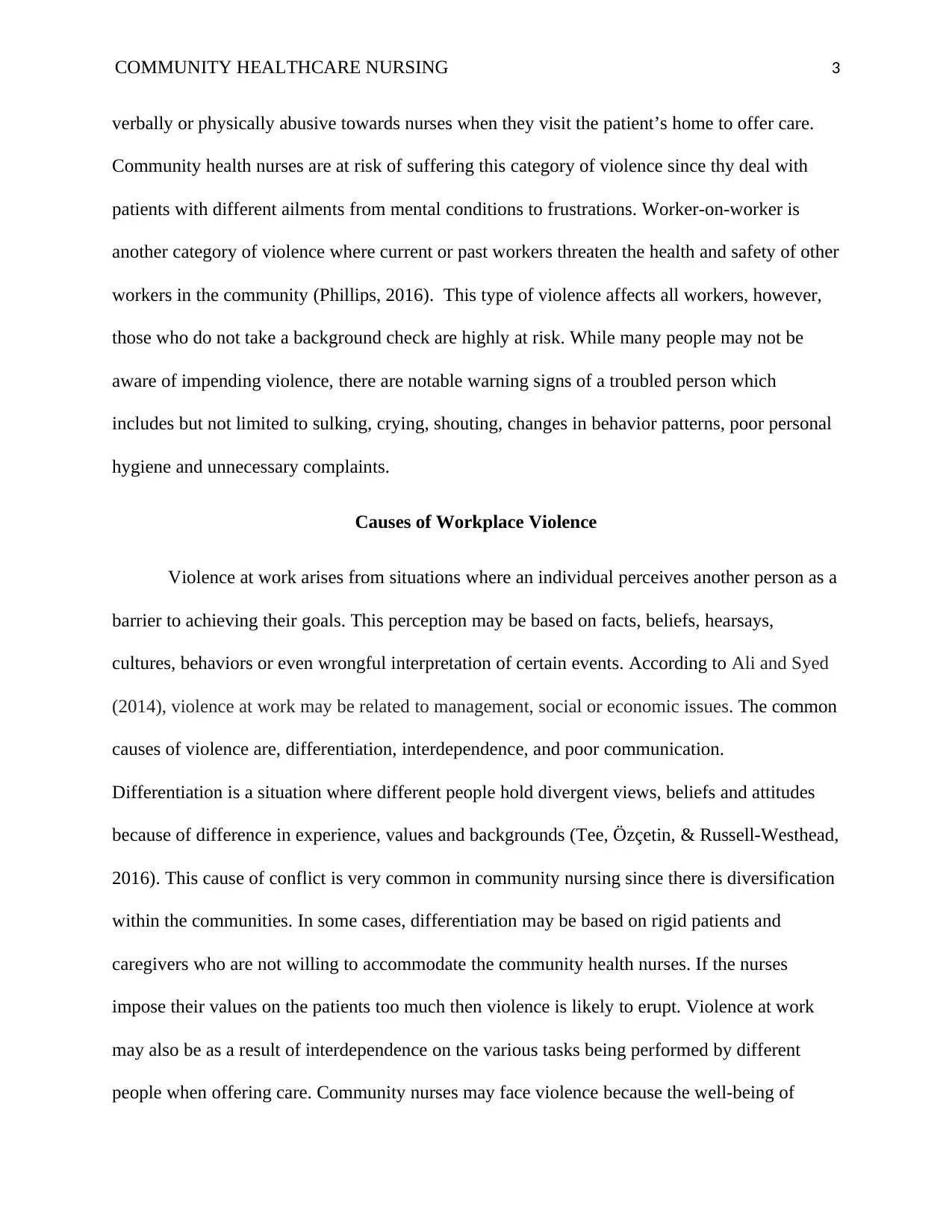
COMMUNITY HEALTHCARE NURSING 3
verbally or physically abusive towards nurses when they visit the patient’s home to offer care.
Community health nurses are at risk of suffering this category of violence since thy deal with
patients with different ailments from mental conditions to frustrations. Worker-on-worker is
another category of violence where current or past workers threaten the health and safety of other
workers in the community (Phillips, 2016). This type of violence affects all workers, however,
those who do not take a background check are highly at risk. While many people may not be
aware of impending violence, there are notable warning signs of a troubled person which
includes but not limited to sulking, crying, shouting, changes in behavior patterns, poor personal
hygiene and unnecessary complaints.
Causes of Workplace Violence
Violence at work arises from situations where an individual perceives another person as a
barrier to achieving their goals. This perception may be based on facts, beliefs, hearsays,
cultures, behaviors or even wrongful interpretation of certain events. According to Ali and Syed
(2014), violence at work may be related to management, social or economic issues. The common
causes of violence are, differentiation, interdependence, and poor communication.
Differentiation is a situation where different people hold divergent views, beliefs and attitudes
because of difference in experience, values and backgrounds (Tee, Özçetin, & Russell-Westhead,
2016). This cause of conflict is very common in community nursing since there is diversification
within the communities. In some cases, differentiation may be based on rigid patients and
caregivers who are not willing to accommodate the community health nurses. If the nurses
impose their values on the patients too much then violence is likely to erupt. Violence at work
may also be as a result of interdependence on the various tasks being performed by different
people when offering care. Community nurses may face violence because the well-being of
verbally or physically abusive towards nurses when they visit the patient’s home to offer care.
Community health nurses are at risk of suffering this category of violence since thy deal with
patients with different ailments from mental conditions to frustrations. Worker-on-worker is
another category of violence where current or past workers threaten the health and safety of other
workers in the community (Phillips, 2016). This type of violence affects all workers, however,
those who do not take a background check are highly at risk. While many people may not be
aware of impending violence, there are notable warning signs of a troubled person which
includes but not limited to sulking, crying, shouting, changes in behavior patterns, poor personal
hygiene and unnecessary complaints.
Causes of Workplace Violence
Violence at work arises from situations where an individual perceives another person as a
barrier to achieving their goals. This perception may be based on facts, beliefs, hearsays,
cultures, behaviors or even wrongful interpretation of certain events. According to Ali and Syed
(2014), violence at work may be related to management, social or economic issues. The common
causes of violence are, differentiation, interdependence, and poor communication.
Differentiation is a situation where different people hold divergent views, beliefs and attitudes
because of difference in experience, values and backgrounds (Tee, Özçetin, & Russell-Westhead,
2016). This cause of conflict is very common in community nursing since there is diversification
within the communities. In some cases, differentiation may be based on rigid patients and
caregivers who are not willing to accommodate the community health nurses. If the nurses
impose their values on the patients too much then violence is likely to erupt. Violence at work
may also be as a result of interdependence on the various tasks being performed by different
people when offering care. Community nurses may face violence because the well-being of
⊘ This is a preview!⊘
Do you want full access?
Subscribe today to unlock all pages.

Trusted by 1+ million students worldwide
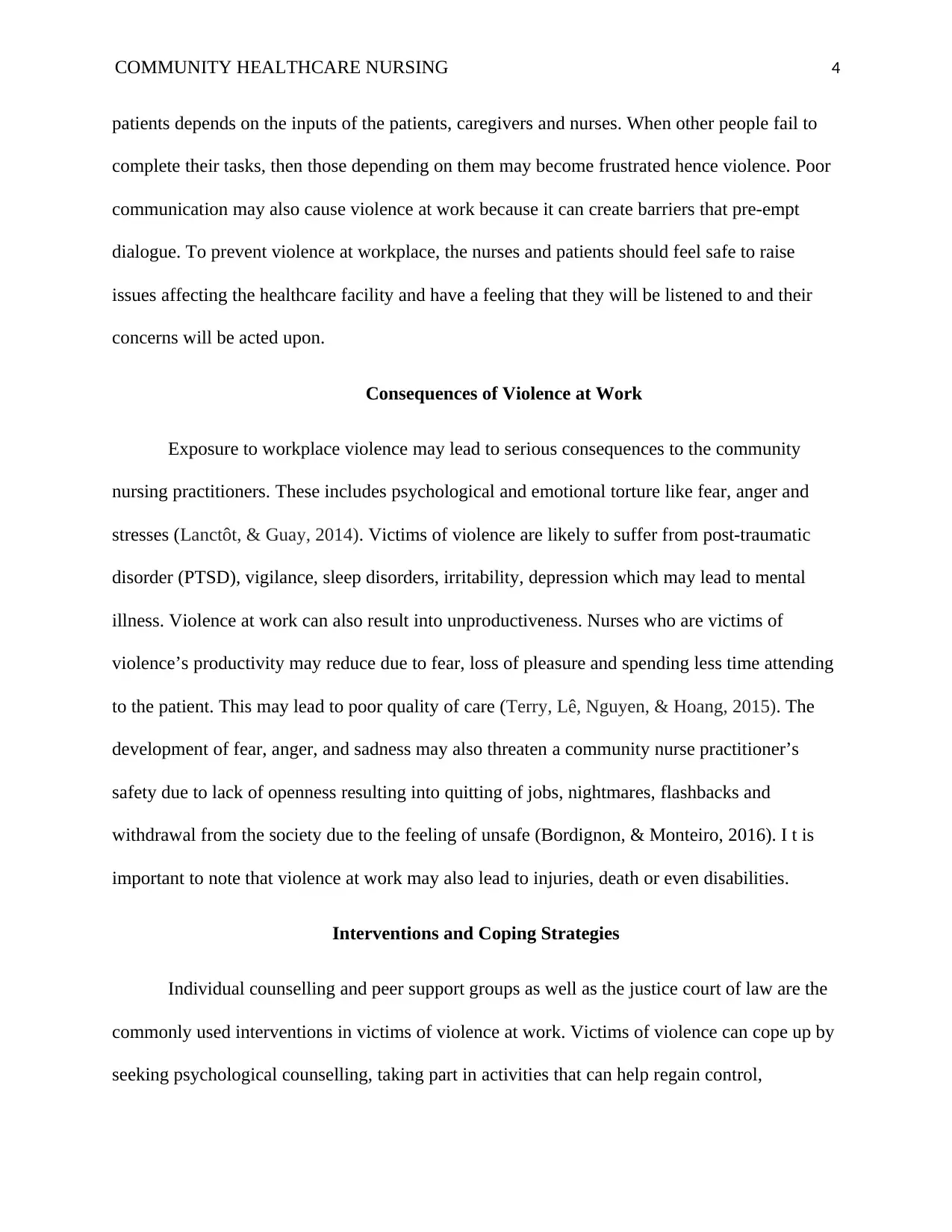
COMMUNITY HEALTHCARE NURSING 4
patients depends on the inputs of the patients, caregivers and nurses. When other people fail to
complete their tasks, then those depending on them may become frustrated hence violence. Poor
communication may also cause violence at work because it can create barriers that pre-empt
dialogue. To prevent violence at workplace, the nurses and patients should feel safe to raise
issues affecting the healthcare facility and have a feeling that they will be listened to and their
concerns will be acted upon.
Consequences of Violence at Work
Exposure to workplace violence may lead to serious consequences to the community
nursing practitioners. These includes psychological and emotional torture like fear, anger and
stresses (Lanctôt, & Guay, 2014). Victims of violence are likely to suffer from post-traumatic
disorder (PTSD), vigilance, sleep disorders, irritability, depression which may lead to mental
illness. Violence at work can also result into unproductiveness. Nurses who are victims of
violence’s productivity may reduce due to fear, loss of pleasure and spending less time attending
to the patient. This may lead to poor quality of care (Terry, Lê, Nguyen, & Hoang, 2015). The
development of fear, anger, and sadness may also threaten a community nurse practitioner’s
safety due to lack of openness resulting into quitting of jobs, nightmares, flashbacks and
withdrawal from the society due to the feeling of unsafe (Bordignon, & Monteiro, 2016). I t is
important to note that violence at work may also lead to injuries, death or even disabilities.
Interventions and Coping Strategies
Individual counselling and peer support groups as well as the justice court of law are the
commonly used interventions in victims of violence at work. Victims of violence can cope up by
seeking psychological counselling, taking part in activities that can help regain control,
patients depends on the inputs of the patients, caregivers and nurses. When other people fail to
complete their tasks, then those depending on them may become frustrated hence violence. Poor
communication may also cause violence at work because it can create barriers that pre-empt
dialogue. To prevent violence at workplace, the nurses and patients should feel safe to raise
issues affecting the healthcare facility and have a feeling that they will be listened to and their
concerns will be acted upon.
Consequences of Violence at Work
Exposure to workplace violence may lead to serious consequences to the community
nursing practitioners. These includes psychological and emotional torture like fear, anger and
stresses (Lanctôt, & Guay, 2014). Victims of violence are likely to suffer from post-traumatic
disorder (PTSD), vigilance, sleep disorders, irritability, depression which may lead to mental
illness. Violence at work can also result into unproductiveness. Nurses who are victims of
violence’s productivity may reduce due to fear, loss of pleasure and spending less time attending
to the patient. This may lead to poor quality of care (Terry, Lê, Nguyen, & Hoang, 2015). The
development of fear, anger, and sadness may also threaten a community nurse practitioner’s
safety due to lack of openness resulting into quitting of jobs, nightmares, flashbacks and
withdrawal from the society due to the feeling of unsafe (Bordignon, & Monteiro, 2016). I t is
important to note that violence at work may also lead to injuries, death or even disabilities.
Interventions and Coping Strategies
Individual counselling and peer support groups as well as the justice court of law are the
commonly used interventions in victims of violence at work. Victims of violence can cope up by
seeking psychological counselling, taking part in activities that can help regain control,
Paraphrase This Document
Need a fresh take? Get an instant paraphrase of this document with our AI Paraphraser
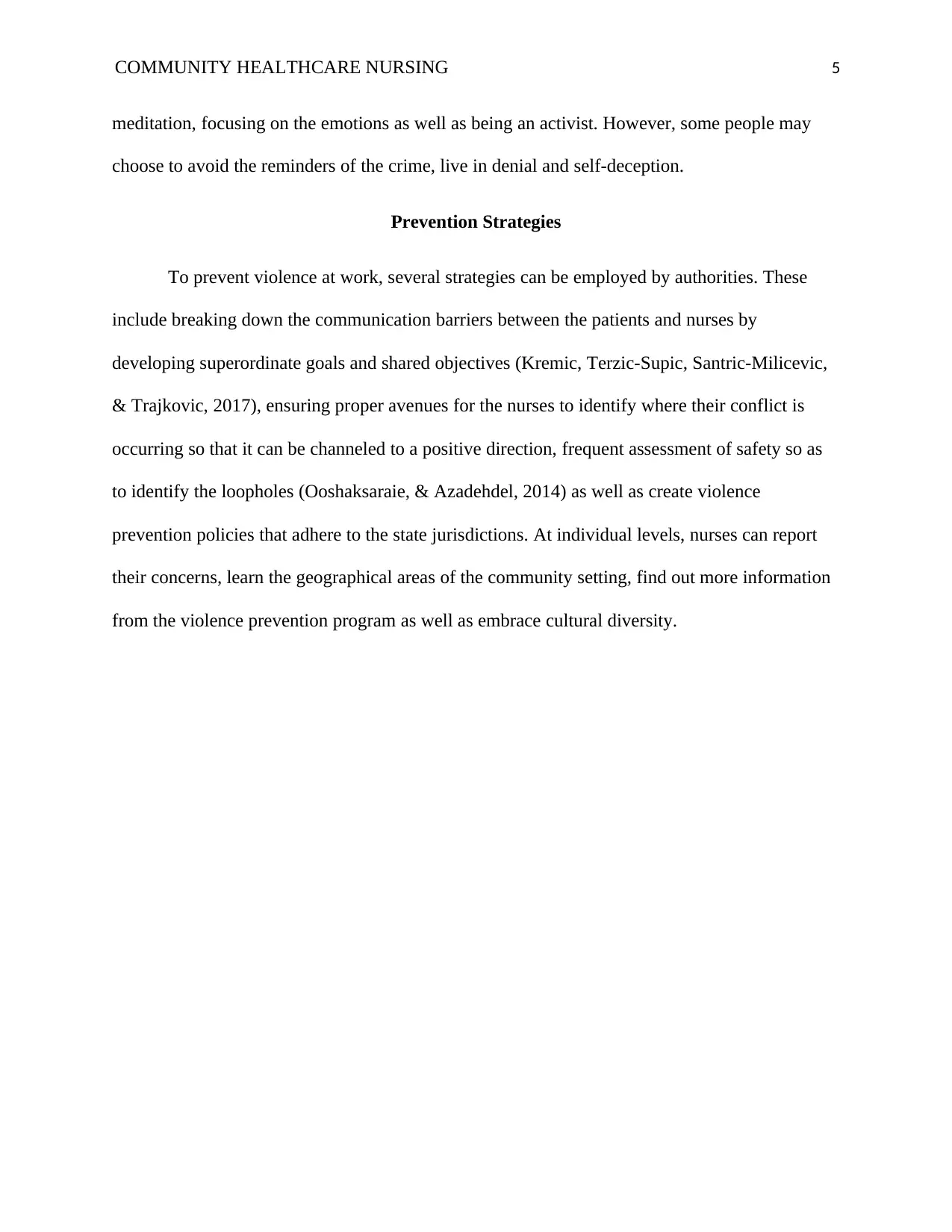
COMMUNITY HEALTHCARE NURSING 5
meditation, focusing on the emotions as well as being an activist. However, some people may
choose to avoid the reminders of the crime, live in denial and self-deception.
Prevention Strategies
To prevent violence at work, several strategies can be employed by authorities. These
include breaking down the communication barriers between the patients and nurses by
developing superordinate goals and shared objectives (Kremic, Terzic-Supic, Santric-Milicevic,
& Trajkovic, 2017), ensuring proper avenues for the nurses to identify where their conflict is
occurring so that it can be channeled to a positive direction, frequent assessment of safety so as
to identify the loopholes (Ooshaksaraie, & Azadehdel, 2014) as well as create violence
prevention policies that adhere to the state jurisdictions. At individual levels, nurses can report
their concerns, learn the geographical areas of the community setting, find out more information
from the violence prevention program as well as embrace cultural diversity.
meditation, focusing on the emotions as well as being an activist. However, some people may
choose to avoid the reminders of the crime, live in denial and self-deception.
Prevention Strategies
To prevent violence at work, several strategies can be employed by authorities. These
include breaking down the communication barriers between the patients and nurses by
developing superordinate goals and shared objectives (Kremic, Terzic-Supic, Santric-Milicevic,
& Trajkovic, 2017), ensuring proper avenues for the nurses to identify where their conflict is
occurring so that it can be channeled to a positive direction, frequent assessment of safety so as
to identify the loopholes (Ooshaksaraie, & Azadehdel, 2014) as well as create violence
prevention policies that adhere to the state jurisdictions. At individual levels, nurses can report
their concerns, learn the geographical areas of the community setting, find out more information
from the violence prevention program as well as embrace cultural diversity.
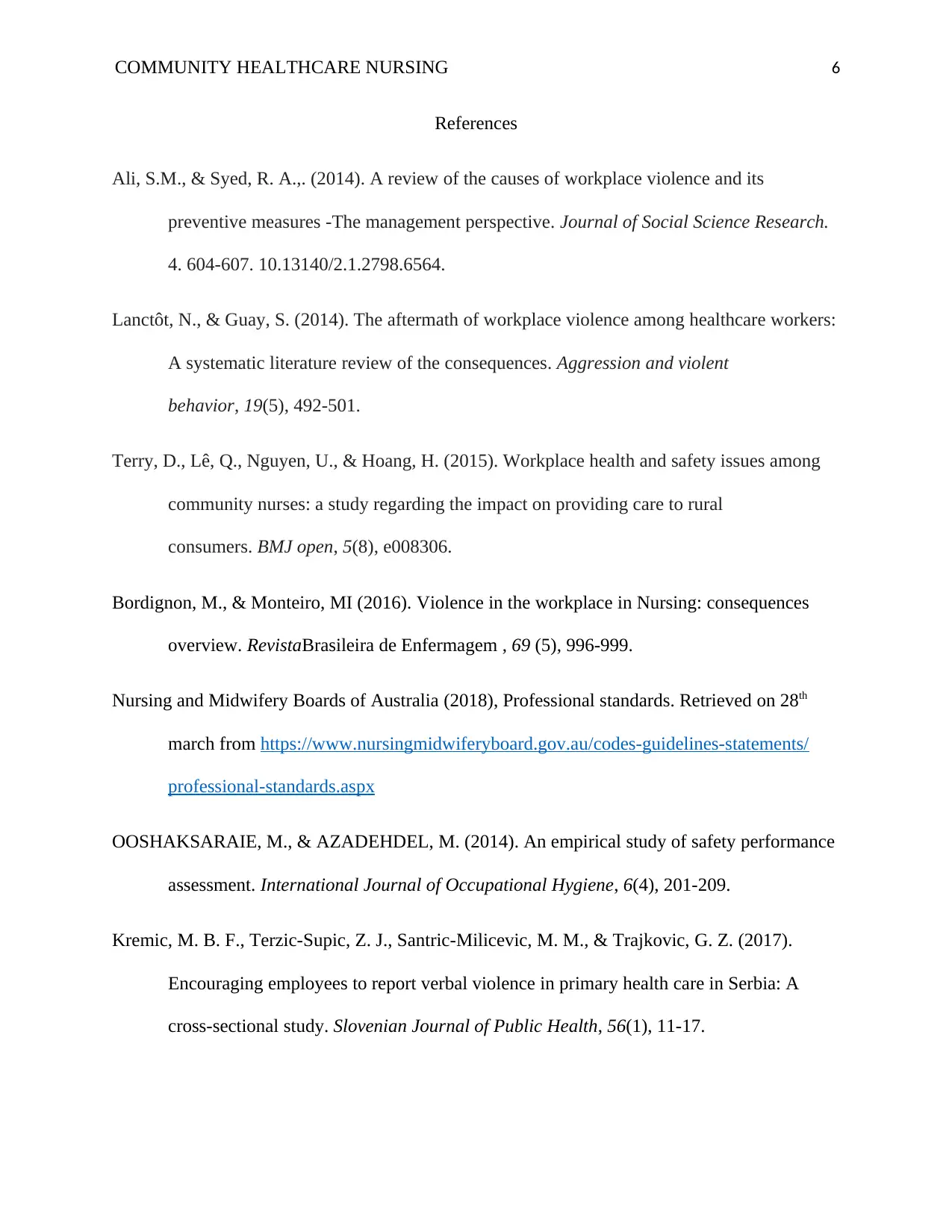
COMMUNITY HEALTHCARE NURSING 6
References
Ali, S.M., & Syed, R. A.,. (2014). A review of the causes of workplace violence and its
preventive measures -The management perspective. Journal of Social Science Research.
4. 604-607. 10.13140/2.1.2798.6564.
Lanctôt, N., & Guay, S. (2014). The aftermath of workplace violence among healthcare workers:
A systematic literature review of the consequences. Aggression and violent
behavior, 19(5), 492-501.
Terry, D., Lê, Q., Nguyen, U., & Hoang, H. (2015). Workplace health and safety issues among
community nurses: a study regarding the impact on providing care to rural
consumers. BMJ open, 5(8), e008306.
Bordignon, M., & Monteiro, MI (2016). Violence in the workplace in Nursing: consequences
overview. RevistaBrasileira de Enfermagem , 69 (5), 996-999.
Nursing and Midwifery Boards of Australia (2018), Professional standards. Retrieved on 28th
march from https://www.nursingmidwiferyboard.gov.au/codes-guidelines-statements/
professional-standards.aspx
OOSHAKSARAIE, M., & AZADEHDEL, M. (2014). An empirical study of safety performance
assessment. International Journal of Occupational Hygiene, 6(4), 201-209.
Kremic, M. B. F., Terzic-Supic, Z. J., Santric-Milicevic, M. M., & Trajkovic, G. Z. (2017).
Encouraging employees to report verbal violence in primary health care in Serbia: A
cross-sectional study. Slovenian Journal of Public Health, 56(1), 11-17.
References
Ali, S.M., & Syed, R. A.,. (2014). A review of the causes of workplace violence and its
preventive measures -The management perspective. Journal of Social Science Research.
4. 604-607. 10.13140/2.1.2798.6564.
Lanctôt, N., & Guay, S. (2014). The aftermath of workplace violence among healthcare workers:
A systematic literature review of the consequences. Aggression and violent
behavior, 19(5), 492-501.
Terry, D., Lê, Q., Nguyen, U., & Hoang, H. (2015). Workplace health and safety issues among
community nurses: a study regarding the impact on providing care to rural
consumers. BMJ open, 5(8), e008306.
Bordignon, M., & Monteiro, MI (2016). Violence in the workplace in Nursing: consequences
overview. RevistaBrasileira de Enfermagem , 69 (5), 996-999.
Nursing and Midwifery Boards of Australia (2018), Professional standards. Retrieved on 28th
march from https://www.nursingmidwiferyboard.gov.au/codes-guidelines-statements/
professional-standards.aspx
OOSHAKSARAIE, M., & AZADEHDEL, M. (2014). An empirical study of safety performance
assessment. International Journal of Occupational Hygiene, 6(4), 201-209.
Kremic, M. B. F., Terzic-Supic, Z. J., Santric-Milicevic, M. M., & Trajkovic, G. Z. (2017).
Encouraging employees to report verbal violence in primary health care in Serbia: A
cross-sectional study. Slovenian Journal of Public Health, 56(1), 11-17.
⊘ This is a preview!⊘
Do you want full access?
Subscribe today to unlock all pages.

Trusted by 1+ million students worldwide
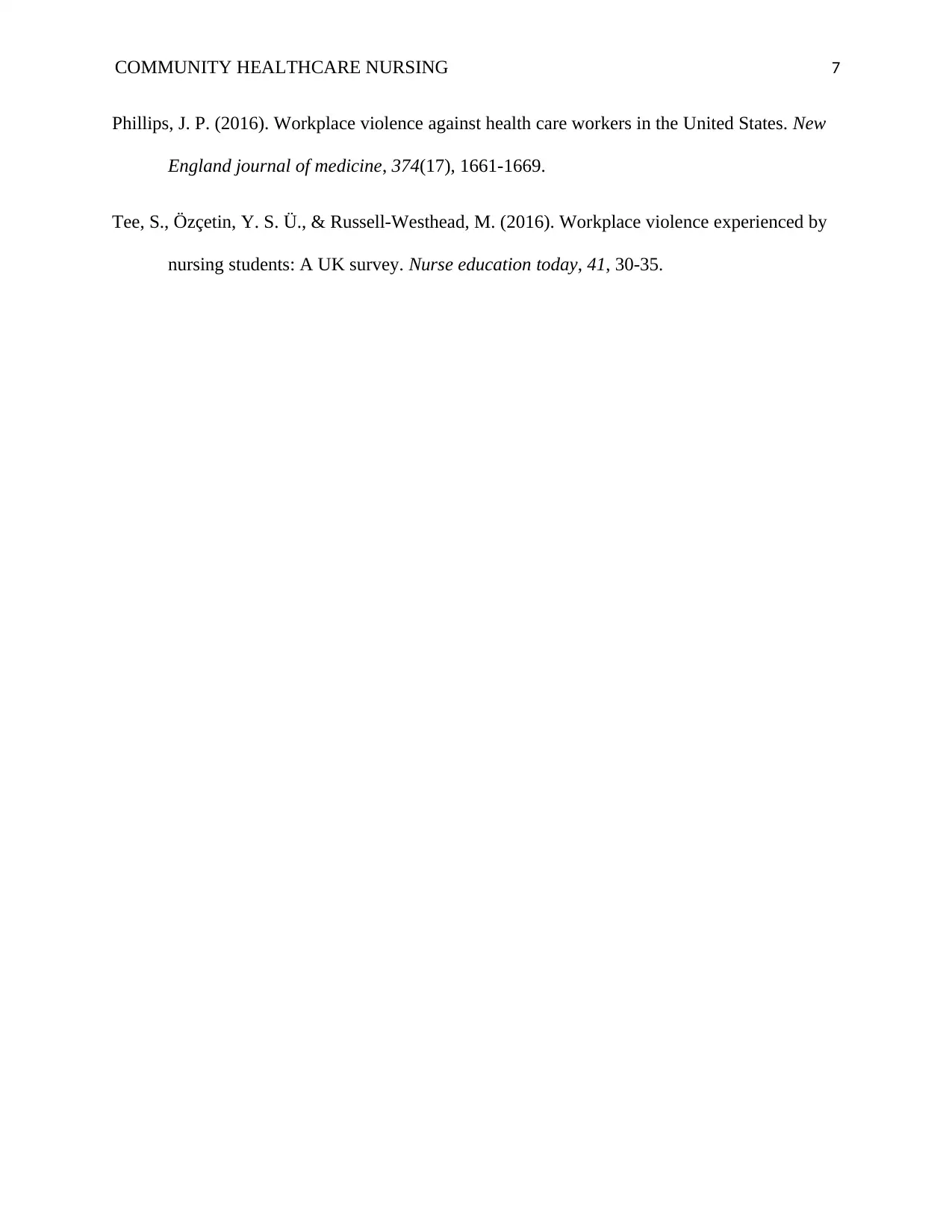
COMMUNITY HEALTHCARE NURSING 7
Phillips, J. P. (2016). Workplace violence against health care workers in the United States. New
England journal of medicine, 374(17), 1661-1669.
Tee, S., Özçetin, Y. S. Ü., & Russell-Westhead, M. (2016). Workplace violence experienced by
nursing students: A UK survey. Nurse education today, 41, 30-35.
Phillips, J. P. (2016). Workplace violence against health care workers in the United States. New
England journal of medicine, 374(17), 1661-1669.
Tee, S., Özçetin, Y. S. Ü., & Russell-Westhead, M. (2016). Workplace violence experienced by
nursing students: A UK survey. Nurse education today, 41, 30-35.
1 out of 7
Related Documents
Your All-in-One AI-Powered Toolkit for Academic Success.
+13062052269
info@desklib.com
Available 24*7 on WhatsApp / Email
![[object Object]](/_next/static/media/star-bottom.7253800d.svg)
Unlock your academic potential
Copyright © 2020–2025 A2Z Services. All Rights Reserved. Developed and managed by ZUCOL.





